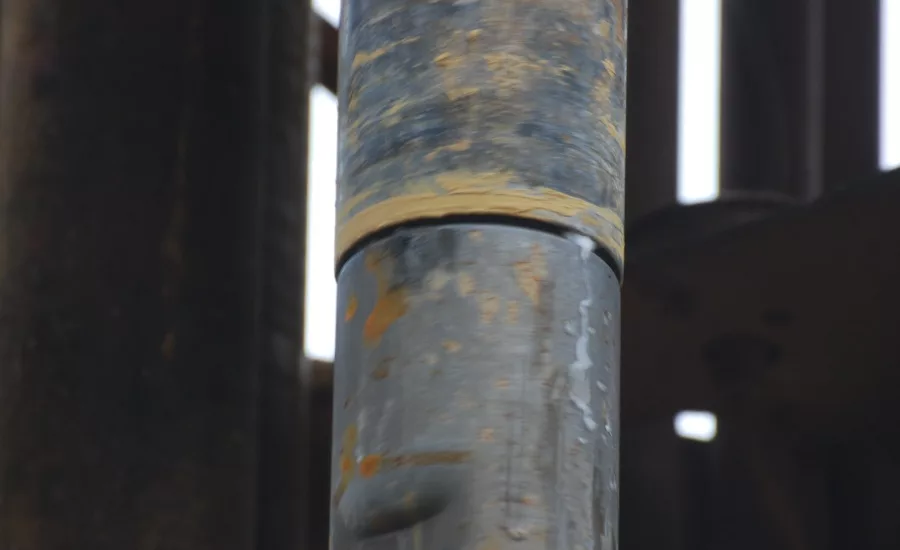Drill Pipe Threads 101: The Basics of Good Connections
Drilling Jobs Depend on a Solid Grip from Pin to Box

Even a small ding in a pipe shoulder can wash out the joint compound and, ultimately, affect uphole velocity.
Source: David King
Recently, buried in thought, I fidgeted with the cap of a bottle of water, twisting the cap on and off. (Yes, even us well owners sometimes drink bottled water.) I noticed how quickly the cap tightened — in far less than a single turn. Curious, I looked at the bottle’s thread. It was a quad lead! Looking down at the bottle opening, four separate threads started in four equally spaced places. Cool, I thought. Multiple-lead threads are utilitzed on some DTH hammer cases, and they are the norm on raise-bore drill pipe. Remember the double-lead threads on those Portadrill blasthole rigs? Multiple leads speed up pipe and tooling connections.
In the drilling industry, and in life, we encounter many different threads. Since I am neither a driller nor plumber, my most common thread use is when I connect a garden hose to the outside faucet. Ever wonder about this thread, or is it just me? Is there an organization that regulates it and sets the standards? Or, does every supplier just know to supply this thread?
Well, I have the answer. The standard thread is a GHT (garden hose thread) or, more formally, an NH (national hose). The standard, as with many everyday things, gets defined by American National Standards Institute (ANSI). We are most familiar with a ¾-inch GHT found on ½-inch and ⅝-inch garden hoses. This has 11½ threads per inch. You might think garden hose thread is the same as pipe thread, but GHT is straight, not tapered like pipe thread. If you want to connect hose to a pipe thread, you need a crossover adapter. Now you know.
We are all familiar with national pipe thread (NPT). This standard features a slight taper (¾-inch taper per foot, or TPF). When you make the connections, they tighten and seal on the threads. We encounter these when running water lines, with some casing and with indoor plumbing. Typically, they use a coupling.
With drill pipe, we typically rely on the standardization provided by the American Petroleum Institute (API). These are called rotary shouldered connections. These are tapered connections but, unlike NPT, they tighten on the shoulders and not the threads themselves. Thread tapers can run from 4- to 5-inch taper per foot — a lot steeper than the national pipe threads.
When connections tighten on the threads, you can help stop leaking by wrapping the threads with plumber’s tape. Garden hoses tighten and seal when the tip of the male threads contacts a flat area at the back of the box, an internal shoulder. To seal this, we use a washer. To seal drill pipe connections, we rely on metal-to-metal contact at the shoulders. We ensure this by utilizing the correct make-up torque. This amount of torque also enables the mated connection to act as a unit, so it does not become a weak point.
A ding can prevent a good seal and the connections could leak. It is not always the depth of the ding but the raised portion of it that prevents proper shouldering.
As you periodically inspect your drill pipe — like I know all well drillers do —pay attention to the thread shoulders. A ding can prevent a good seal and the connections could leak. It is not always the depth of the ding but the raised portion of it that prevents proper shouldering. Other than enabling a leak, improper shouldering is a lead cause of thread failure due to breakage (like snapping off a pin).
Other than working like one of those yard sprinklers we used to run through as kids and getting the operator and helper wet, these can also wash out the tool joint compound and lessen the amount of air entering the drill string. Less air could mean lower uphole velocity, and translate into not-so-good hole cleaning and shorter bit life.
Most drill pipe manufacturers machine an outside bevel on the thread shoulders. Not only does this provide the correct surface area for torqueing purposes, it helps protect the shoulder from dings that may happen while handling the drill pipe.
Another way to safeguard shoulders is to use the thread protectors that came with the drill pipe. Some will save the pin protectors and religiously use them, but using the box protectors can also protect those box shoulders.
Have a leaky top sub? It could be from shoulder damage or it could be due to thread damage. All of your drill pipe connects with your top sub. Thread damage in that top sub can cause thread damage in every drill pipe you use. Do not just ignore it. Inspect, and repair or replace if you find damage.
For repair, you could send your top sub in to have the bottom threads recut. Or, you might find a bad spot that can be addressed with a file or hand grinder. Some rigs do not permit such recutting, since you will lose ¾ inches or more in length (up to 2½ inches with severe damage). You want to make sure it does not become too short to pick your drill pipe out of the table.
Leaky connections lead to leaky wallets. It is worth the time to investigate and make it right.
For more Pipeline columns, visit www.thedriller.com/pipeline.
Looking for a reprint of this article?
From high-res PDFs to custom plaques, order your copy today!





